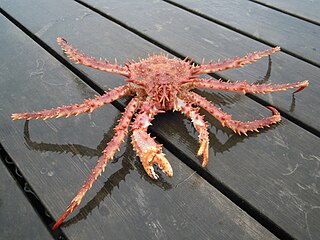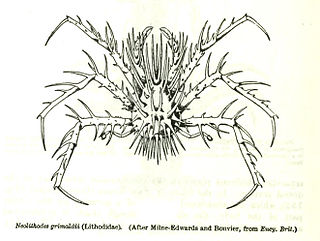
King crabs are a taxon of decapod crustaceans that are chiefly found in cold seas. Because of their large size and the taste of their meat, many species are widely caught and sold as food with the most common being the red king crab.

Squat lobsters are dorsoventrally flattened crustaceans with long tails held curled beneath the cephalothorax. They are found in the two superfamilies Galatheoidea and Chirostyloidea, which form part of the decapod infraorder Anomura, alongside groups including the hermit crabs and mole crabs. They are distributed worldwide in the oceans, and occur from near the surface to deep sea hydrothermal vents, with one species occupying caves above sea level. More than 900 species have been described, in around 60 genera. Some species form dense aggregations, either on the sea floor or in the water column, and a small number are commercially fished.

Anomura is a group of decapod crustaceans, including hermit crabs and others. Although the names of many anomurans include the word crab, all true crabs are in the sister group to the Anomura, the Brachyura.

Lithodes maja, the Norway king crab or northern stone crab, is a species of king crab which occurs in colder North Atlantic waters off Europe and North America. It is found along the entire coast of Norway, including Svalbard, ranging south into the North Sea and Kattegat, the northern half of the British Isles, and around the Faroe Islands, Iceland, and off south-eastern Greenland. In the West Atlantic, it ranges from the Davis Strait between Greenland and Canada south to The Carolinas in the United States.

Lithodes santolla, also known as the southern king crab, Chilean king crab or centolla, is a species of king crab, found off southern South America including the offshore Falkland Islands. On the Pacific side, it is found in Chile from Talcahuano to Cape Horn. On the Atlantic side, it is found off Argentina and Uruguay. It lives in the benthic zone at depths of 0–700 m (0–2,300 ft), with Uruguayan records being exclusively from great depths. In Chile, it mostly lives at depths to 150 m (490 ft), but south of 40° S it can be found to 600 m (2,000 ft). It is a large crab that can reach up to 19 cm (7.5 in) in carapace length, and it is the target of commercial fishing.
Paralomis africana is a species of king crab found off the coast of Namibia. It has been found from 570–770 metres (1,870–2,530 ft). Its carapace is pentagonal and has been measured to a width of 74.2 millimetres (2.92 in) and a length of 65.8 millimetres (2.59 in).

Munidopsis serricornis is a species of squat lobster. It is widely distributed in the world's oceans, being found in the eastern Atlantic Ocean, the western Atlantic Ocean, and the Indo-Pacific. It grows up to a carapace length of 20 millimetres (0.8 in).

Munidopsis is a genus of squat lobster. It is the second largest of all the genera of squat lobsters, after Munida, with over 200 species. Its members are mainly found on continental slopes and on abyssal plains. A few fossil species are also known, including specimens from the Campanian (Cretaceous).

Lithodes is a genus of king crabs. Today there are about 30 recognized species, but others formerly included in this genus have been moved to Neolithodes and Paralomis. They are found in oceans around the world, ranging from shallow to deep waters, but mostly at depths of 100–1,000 m (300–3,300 ft). They are restricted to relatively cold waters, meaning that they only occur at high depths at low latitudes, but some species also shallower at high latitudes. They are medium to large crabs, and some species are or were targeted by fisheries.

Agononida is a genus of squat lobsters in the family Munididae. In 2022, recognizing that the genus as then defined was paraphyletic, it was divided into three lineages: Agononidasensu stricto and two new genera, Garymunida and Hexamunida. Agononida is distributed in the Indian and Pacific Oceans.
Anomoeomunida is a monotypic squat lobster genus in the family Munididae. The sole a species of is Anomoeomunida caribensis. It occurs in the western Atlantic.

Raymunida is a genus of squat lobsters in the family Munididae, containing the following 11 species:

Neolithodes is a genus of king crabs, in the family Lithodidae. They are found in all major oceans, both in high and low latitudes. Although there are records from water as shallow as 124 m (407 ft) in cold regions, most records are much deeper, typically 700–2,000 m (2,300–6,600 ft), with the deepest confirmed at 5,238 m (17,185 ft). They are fairly large to large crabs that typically are reddish in color and spiny, although the size of these spines varies depending on species.

Neolithodes grimaldii, the porcupine crab, is a species of king crab in the family Lithodidae. This large red crab is found in cold deep waters in the North Atlantic and often caught as a bycatch in fisheries for Greenland turbot. As suggested by its common name, the carapace and legs are covered in long spines.

Raymunida confundens is a species of squat lobster in the family Munididae from the Pacific and Indian oceans. The species can be distinguished by its morphological characters and its mitochondrial cytochrome c oxidase subunit I sequences.

Neolithodes agassizii is a species of king crab native to the Western Atlantic. They live at depths of 200–1,900 metres (660–6,230 ft), and have been found as far south as Rio de Janeiro, as far north as latitude 36°, and near the Equator. It has been found in the southwestern Caribbean Sea as well as the Gulf of Mexico.
Neolithodes capensis is a species of king crab which is found in the Southern Ocean and the western Indian Ocean. It has been found to a depth of 660–3,200 metres (2,170–10,500 ft).

Neolithodes diomedeae is a species of king crab which is found in the eastern Pacific Ocean, the southwestern Atlantic Ocean, and the Bellingshausen and Scotia Seas in the Southern Ocean. They occur from 200 to 2,454 m.
Lithodes turkayi is a species of king crab.
Lithodes manningi is a species of king crab.











